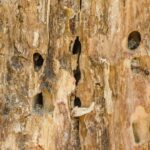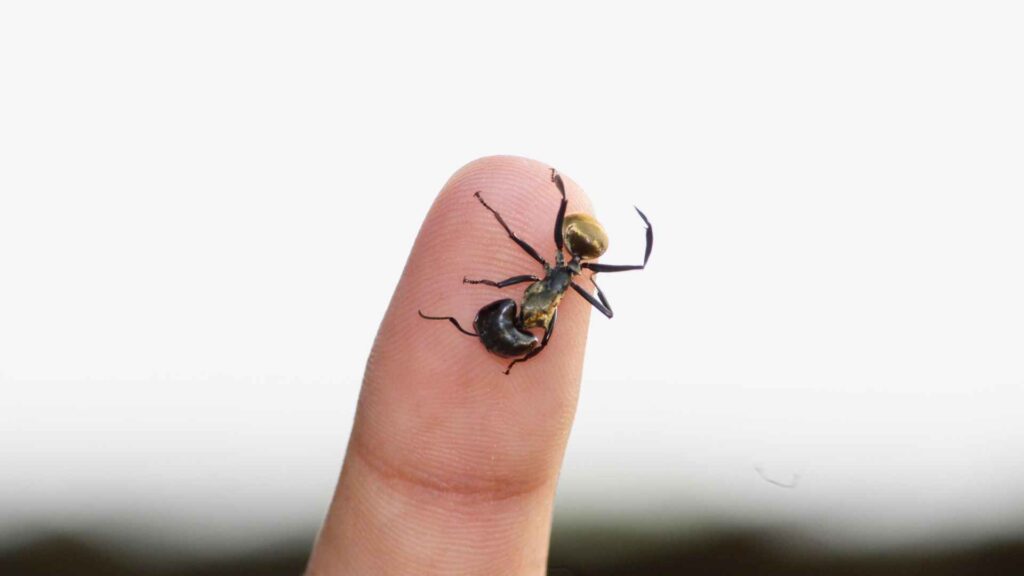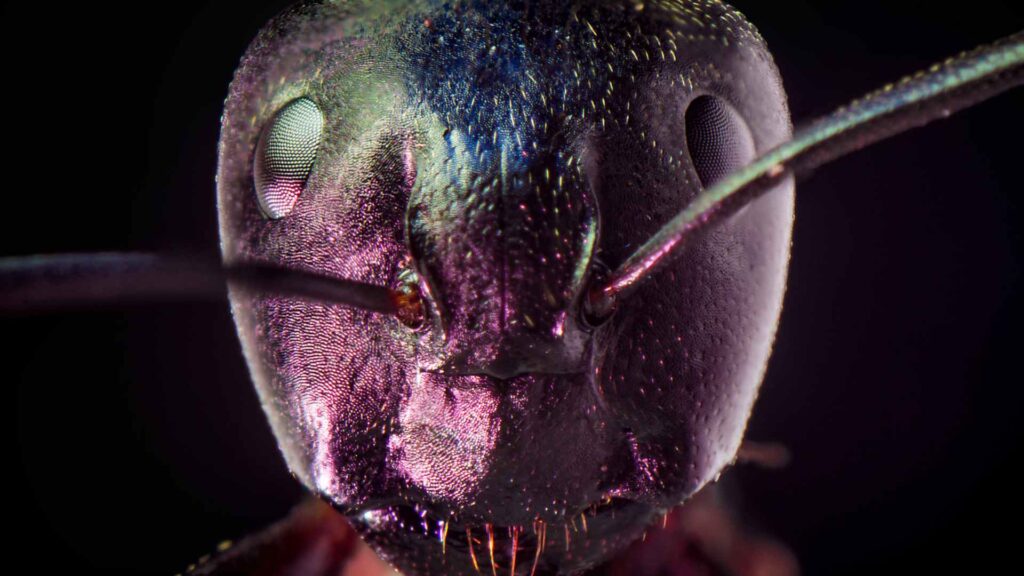Have you noticed an increase in ant activity around your home? Are you seeing piles of strange sawdust-like material near your baseboards?
If so, you might be facing a carpenter ant infestation.
Unlike their cousins the termites, carpenter ants don’t eat wood – they burrow through it, creating nests that can cause serious structural damage.
This guide will equip you with the knowledge to identify carpenter ant nests and take action before they become a costly problem.
Understanding Carpenter Ant Nests
Unlike termites that eat wood, carpenter ants burrow through it to create tunnels and chambers for their nests. These nests can be located both indoors and outdoors, posing a threat to your property.
Differences Between Carpenter Ant Nests and Other Ant Nests
While all ants might seem similar at first glance, there are key differences between carpenter ant nests and those of other common ant species. Here’s a breakdown to help you identify a potential carpenter ant problem:
| Feature |
Carpenter Ant Nest |
Other Ant Nest (e.g., Fire Ants, House Ants) |
| Location |
Built within wood (indoors or outdoors) |
Typically outdoors in soil, under pavement, or inside walls |
| Visible Signs |
Piles of sawdust-like material (frass) near entry points, smooth, oval-shaped holes in wood |
Mounds of dirt above ground (fire ants), trails of ants, or small openings near baseboards |
| Winged Ants (Alates) |
Present, especially during swarming season |
Less common, may not be visible |
| Damage |
Can cause structural damage by tunneling through wood |
Primarily a nuisance, minimal structural damage |
| Moisture Dependence |
Often attracted to moist or damp environments |
Can thrive in various conditions, including dry areas |
Early detection of a carpenter ant nest is crucial. Left unchecked, these industrious insects can cause significant structural damage to your home. By recognizing the signs of a carpenter ant nest, you can take swift action to control the infestation before it becomes a costly problem.
Identifying a Carpenter Ant Nest
Identifying a carpenter ant nest requires a keen eye for both visual indicators and behavioral clues left behind by these industrious insects. Here’s a detailed breakdown to help you become a carpent
er ant nest detection expert:
Visual Indicators

- Frass Frenzy: Carpenter ants don’t eat wood, but they sure do excavate it! Keep an eye out for piles of sawdust-like material called frass. This coarse, wood shaving debris is often the first giveaway of a carpenter ant infestation. Look for it near:
- Entry points: These could be cracks around windows, doors, foundations, or utility lines.
- Baseboards: Check for frass accumulating along baseboards, especially near areas of moisture or behind furniture.
- Woodworking: Inspect areas like cabinets, door frames, and even furniture for piles of frass, indicating potential tunneling activity within.

- Hidden Tunnels: Unlike termites who eat wood, carpenter ants burrow tunnels for nesting and travel. Here’s what to look for:
- Smooth, oval-shaped holes in wood structures like walls, doors, furniture, or baseboards. These are entry and exit points for worker ants.
- Rustling sounds emanating from within walls or furniture, especially at night, could indicate carpenter ant activity within the tunnels.
Behavioral Indicators
- Increased Ant Activity, Especially at Night: Carpenter ants are generally more nocturnal than other ant species. If you notice a sudden surge in ant traffic, particularly after dark, around specific areas of your home, it could be a sign of a nearby nest. Pay attention to:
- Trails of ants: These can lead you to the source of the activity, potentially a hidden nest entrance.
- Specific areas: Look for increased activity around areas with moisture, like kitchens, bathrooms, or laundry rooms.
- Winged Ants Emerging from Walls or Ceilings: The presence of winged carpenter ants, also known as alates, is a crucial sign. These reproductive ants emerge from mature colonies during swarming season (spring or summer) to mate and establish new nests. If you see winged carpenter ants indoors, it suggests a potential nesting site within your home.
<💡
Bonus Tip: If you suspect a carpenter ant nest but can’t locate it visually, try placing a piece of masking tape around a suspected entry point. Carpenter ants will leave a trail of pheromones (scent) on the tape as they travel. After a few hours, remove the tape and follow the trail of ants to locate the nest (if it’s nearby).>
Location and Structure of Carpenter Ant Nests
Carpenter ants are opportunistic nesters, drawn to environments that provide them with the ideal combination of moisture and shelter. Here’s a breakdown of their favorite indoor and outdoor haunts:
Indoor Carpenter Ant Nests
- Moisture Magnets: Carpenter ants are highly attracted to areas with moisture damage or excessive humidity. Common indoor nesting sites include:
- Crawl spaces: These damp, dark areas are prime real estate for carpenter ants, especially if there are leaks or poor ventilation.
- Behind walls and ceilings: Wall voids provide hidden spaces for nest construction, particularly near areas like bathrooms, kitchens, or laundry rooms where moisture can accumulate.
- Insulation nightmares: Insulation within walls or attics can provide warmth and create a perfect nesting environment for carpenter ants.
- Hollow havens: Pre-existing hollow spaces within structures, like hollow doors or furniture frames, can be attractive nesting sites for smaller carpenter ant colonies.
Outdoor Carpenter Ant Nests
- Decaying wood delights: Outdoors, carpenter ants gravitate towards decaying wood structures that offer them ample burrowing opportunities. Keep an eye out for:
- Tree stumps and logs: These are prime nesting sites, especially if located near your foundation or close to the house.
- Firewood piles: A convenient source of both shelter and moisture, firewood piles stacked near your home can become breeding grounds for carpenter ant colonies.
- Wooden structures: Decks, fences, sheds, or other wooden structures with moisture damage or cracks can harbor carpenter ant nests.
No More Ants: Let Our Skilled Team Safeguard Your Space!
Causes and Risk Factors: Why Carpenter Ants Set Up Shop in Your Home

Carpenter ants aren’t exactly picky eaters when it comes to finding a place to live, but certain factors create a five-star hotel experience in their eyes. Here’s a deeper dive into the key causes and risk factors that attract these unwanted guests:
- Moisture Mania: Carpenter ants have a serious case of “moisture envy.” Leaky pipes, faulty roofs, or improper drainage around your foundation can create damp environments that are like a siren song to these moisture-loving insects.
- Decaying Wood Delight: Just like a delicious buffet for us, decaying wood both indoors and outdoors is a carpenter ant’s dream come true. Soft, rotten wood provides the perfect material for them to burrow and create their elaborate tunnel networks.
- Food Fiesta Frenzy: Don’t underestimate a carpenter ant’s appetite! These omnivores are drawn to readily available food sources like crumbs, sugary spills, and even pet food. Leaving food readily accessible indoors is a one-way ticket to attracting carpenter ants.
High-Risk Zones: Carpenter Ant Happy Places in Your Home
Now that you know what attracts carpenter ants, let’s identify the specific areas in your home most susceptible to infestation:
- Plumbing Perils: Areas around sinks, bathtubs, and dishwashers are prime targets due to potential leaks and the constant presence of moisture.
- Basement Blues: Leaky basements and crawl spaces create a damp, dark haven for carpenter ants to build their nests. Ensure proper ventilation and address any moisture issues in these areas.
- Attic Ambush: Poor ventilation in attics can lead to moisture buildup, making them ideal nesting grounds for carpenter ants.
- Window and Door Woes: Cracks and gaps around windows and doors can provide entry points for carpenter ants, especially in areas prone to moisture accumulation. Regular inspection and sealing of these areas is crucial.
Damage Done: The Cost of Ignoring a Carpenter Ant Infestation

Carpenter ant infestations are more than just a nuisance; they can cause significant structural damage to your home. Here’s why you shouldn’t take them lightly:
- Tunneling Terror: Carpenter ants create a network of tunnels as they burrow through wood. Over time, this extensive tunneling weakens the structural integrity of your home’s wooden supports, potentially leading to serious safety concerns.
- Termite vs. Carpenter Ant Damage: While both can be destructive, it’s important to understand the distinction between carpenter ant and termite damage. Carpenter ants don’t eat wood, but they do excavate tunnels within it. Termites, on the other hand, feed on wood as their primary food source, which can lead to more extensive structural damage if left unchecked.
Addressing carpenter ant damage can be a costly affair. The longer an infestation goes unnoticed, the more extensive the damage becomes, leading to higher repair costs. Early detection and intervention are key to minimizing the financial impact of a carpenter ant problem.
Ant Problems? Get Fast, Effective Solutions by Contacting Us!
Carpenter Ant Nest Prevention Checklist
- [ ] Seal Entry Points: Inspect and seal any cracks, gaps, or openings in the exterior of your home, including around doors, windows, utility lines, and vents.
- [ ] Trim Trees and Shrubs: Keep trees and shrubs trimmed and away from the house to eliminate bridges that ants could use to access your home.
- [ ] Remove Wood-to-Ground Contact: Avoid direct contact between wood structures (like decks, fences, and posts) and the ground. Use concrete or metal supports where possible.
- [ ] Store Firewood Properly: Keep firewood stored away from your home and elevated off the ground to prevent ants from nesting in it.
- [ ] Reduce Moisture: Address any moisture issues in and around your home, including fixing leaks, repairing gutters, and ensuring proper drainage away from the foundation.
- [ ] Keep Indoors Clean: Regularly clean and vacuum your home to remove crumbs, spills, and other food sources that may attract ants.
- [ ] Secure Food and Trash: Store food in airtight containers, keep countertops clean, and dispose of trash regularly in sealed bins.
- [ ] Inspect and Maintain: Regularly inspect areas prone to ant activity, such as basements, crawl spaces, attics, and garages. Fix any issues promptly.
- [ ] Professional Inspection: Schedule regular inspections by a pest control professional to detect and address any ant infestations early on.
Dealing with an Active Infestation

Unfortunately, you’ve discovered carpenter ants in your home. Here are steps to take to address the issue:
Step 1: Identify the Ant
Not all ant sightings are cause for major alarm. While some household ant species are a nuisance, carpenter ants pose a bigger threat due to their potential for structural damage. Here’s how to tell:
- Size: Carpenter ants are larger than typical household ants, ranging from ¼ to ½ inch in length.
- Body: Look for a smoothly rounded thorax (middle section) and a single bump where the body connects to the thorax (some ants have two bumps).
- Color: Black is the most common color for carpenter ants, but they can also be reddish-brown.
If you’re unsure about the type of ant you’re dealing with, consider contacting a pest control professional for a definitive identification.
Step 2: Locate the Nest (if possible)
Finding the nest is crucial for effective treatment. Look for the following signs:
- Frass: Carpenter ants don’t eat wood, but they excavate tunnels within it. Look for piles of sawdust-like material (frass) near walls, baseboards, or doors.
- Forager Trails: Observe the movement of ants inside your home. They leave pheromone trails to guide other ants to food sources. Following these trails might lead you to the nest location.
- Rustling Sounds: Carpenter ants are active at night. During quiet hours, listen for rustling sounds within walls or furniture that might indicate ant activity.
Step 3: Choose a Control Method
Depending on the severity of the infestation, you can consider DIY methods or professional help:
- DIY Methods (for smaller infestations):
- Ant Baits: These contain a slow-acting poison that worker ants carry back to the nest, eliminating the queen and the colony over time.
- Ant Sprays: Sprays can kill ants on contact, but they won’t necessarily eliminate the entire colony.
Step 4: When to Call a Professional
There are situations where
professional help is highly recommended:
- Large or Established Infestations: DIY methods might not be effective for extensive infestations. Professionals have access to stronger insecticides and can locate and eliminate the nest directly.
- Difficulty Locating the Nest: If you can’t find the nest after thorough searching, a professional can use specialized techniques for nest detection.
- Ineffectiveness of DIY Methods: If you’ve tried DIY methods without success, calling a professional ensures a more targeted and effective treatment plan.
Don’t hesitate to
contact us if you have a carpenter ants problem.
Final Thoughts: Protecting Your Home from Carpenter Ant Infestations
As a seasoned pest control expert, I emphasize the importance of early detection and prevention in managing carpenter ant issues effectively. Understanding the nesting behaviors and signs of infestation empowers homeowners to take proactive steps in safeguarding their properties. Regular inspections, addressing risk factors promptly, and seeking professional assistance when needed are key strategies in carpenter ant prevention.
In summary, carpenter ants pose a serious threat to homes, highlighting the need for vigilance and proactive measures. Early detection mitigates potential damage and saves on costly repairs. By maintaining a clean environment, eliminating moisture sources, and seeking professional pest control services when necessary, homeowners can successfully keep carpenter ants at bay and enjoy a pest-free living space.


 Carpenter ants aren’t exactly picky eaters when it comes to finding a place to live, but certain factors create a five-star hotel experience in their eyes. Here’s a deeper dive into the key causes and risk factors that attract these unwanted guests:
Carpenter ants aren’t exactly picky eaters when it comes to finding a place to live, but certain factors create a five-star hotel experience in their eyes. Here’s a deeper dive into the key causes and risk factors that attract these unwanted guests:
 Carpenter ant infestations are more than just a nuisance; they can cause significant structural damage to your home. Here’s why you shouldn’t take them lightly:
Carpenter ant infestations are more than just a nuisance; they can cause significant structural damage to your home. Here’s why you shouldn’t take them lightly:
 Unfortunately, you’ve discovered carpenter ants in your home. Here are steps to take to address the issue:
Unfortunately, you’ve discovered carpenter ants in your home. Here are steps to take to address the issue: